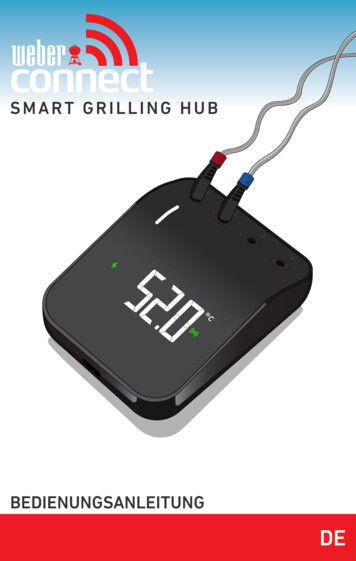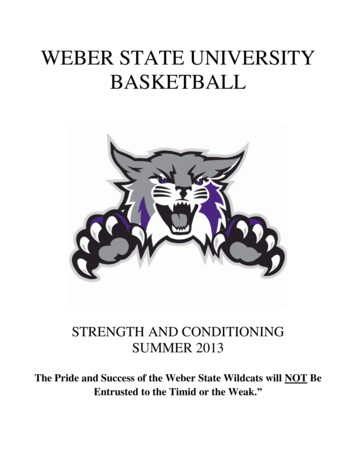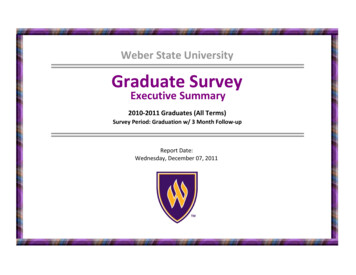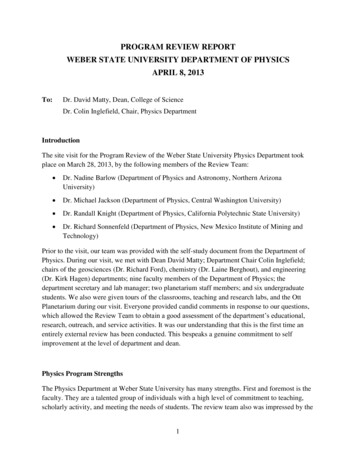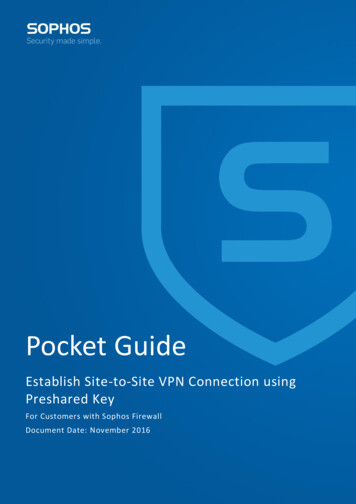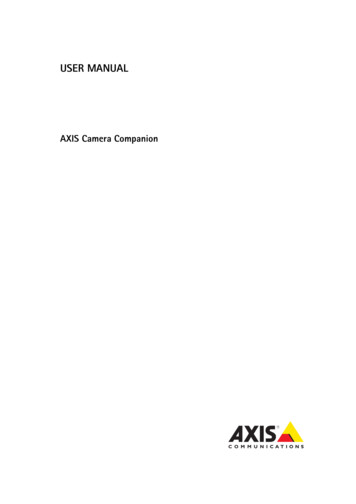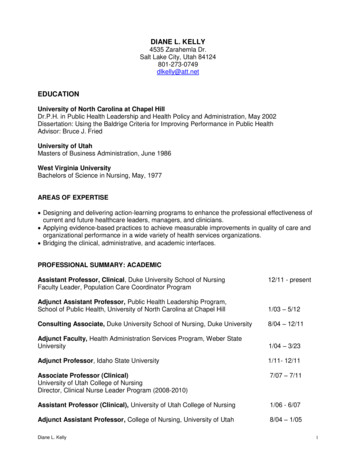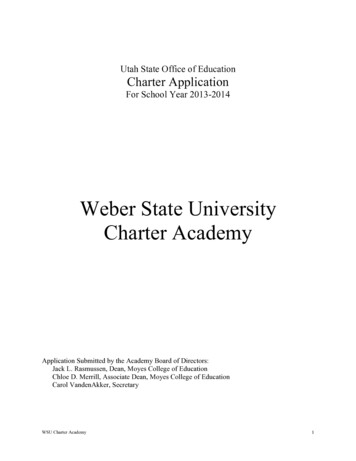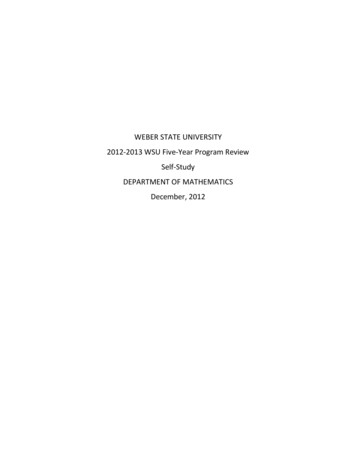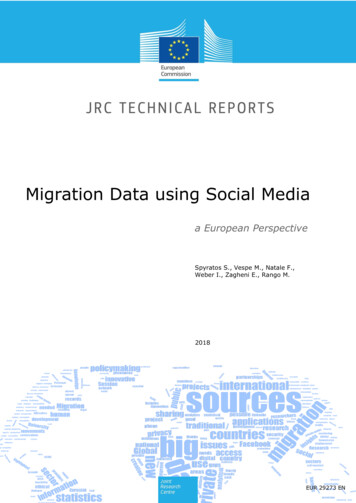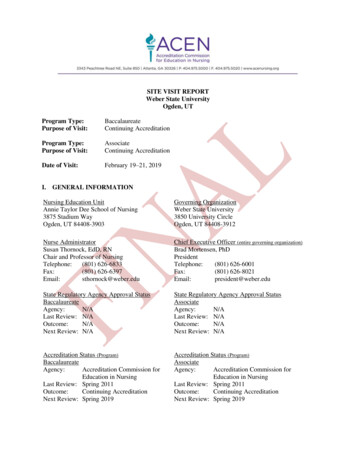
Transcription
SITE VISIT REPORTWeber State UniversityOgden, UTProgram Type:Purpose of Visit:BaccalaureateContinuing AccreditationProgram Type:Purpose of Visit:AssociateContinuing AccreditationDate of Visit:February 19–21, 2019I.GENERAL INFORMATIONNursing Education UnitAnnie Taylor Dee School of Nursing3875 Stadium WayOgden, UT 84408-3903Governing OrganizationWeber State University3850 University CircleOgden, UT 84408-3912Nurse AdministratorSusan Thornock, EdD, RNChair and Professor of NursingTelephone:(801) 626-6833Fax:(801) 626-6397Email:sthornock@weber.eduChief Executive Officer (entire governing organization)Brad Mortensen, PhDPresidentTelephone:(801) 626-6001Fax:(801) 626-8021Email:president@weber.eduState Regulatory Agency Approval StatusBaccalaureateAgency:N/ALast Review: N/AOutcome:N/ANext Review: N/AState Regulatory Agency Approval StatusAssociateAgency:N/ALast Review: N/AOutcome:N/ANext Review: N/AAccreditation Status (Program)BaccalaureateAgency:Accreditation Commission forEducation in NursingLast Review: Spring 2011Outcome:Continuing AccreditationNext Review: Spring 2019Accreditation Status (Program)AssociateAgency:Accreditation Commission forEducation in NursingLast Review: Spring 2011Outcome:Continuing AccreditationNext Review: Spring 2019
Weber State UniversityBaccalaureate/AssociateAccreditation Status (Governing Organization)Agency:Northwest Commission onColleges and UniversitiesLast Review: 2014Outcome:Reaffirmation of AccreditationNext Review: 20212
Weber State UniversityBaccalaureate/Associate3II. SITE VISIT INFORMATIONSite Visit Team:ChairpersonShellye A. Vardaman, PhD, RN-BC, NEA-BC,CNEProfessorTroy University School of Nursing400 Pell AvenueTroy, AL 36082Telephone:(334) 670-3429Fax:(334) 670-3744Email:svardaman@troy.eduMemberSara Bishop, PhD, RNC-OB, CNEAssociate ProfessorStephen F. Austin State University5707 North StreetNacogdoches, TX 75965Telephone:(936) 468-7704Fax:(936) 468-7701Email:bishopse@sfasu.eduMemberElizabeth Ortiz, MSN, RNNursing InstructorDelaware Technical Community College100 Campus AvenueDover, DE 19904Telephone:(302) 857-1317Fax:(302) 857-1398Email:esortiz@dtcc.eduMemberAnna Nguyen, PhD, RNDirector of Nurse Science Department OklahomaState University – Oklahoma City900 North Portland AvenueOklahoma City, OK 73107Telephone:(405) 945-3210Fax:(405) 209-3175Email:nguyena@osuokc.eduMemberGenell Stites, MSN, RNC, C-EFMDirector of PN and LPN-to-AAS ProgramsDepartment of Health SciencesColorado Mesa University1100 North AvenueGrand Junction, CO 81501Telephone:(970) 248-1828Fax:(970) 210-4755Email:gstites@coloradomesa.eduMemberSusan (Sue) Dolinar, PhD, RN, CNEAdjunct Faculty for the Nursing DepartmentGreenville Technical College506 South Pleasantburg DrivePO Box 5616Greenville, SC 29606Telephone:(864) 250-8199Fax:(864) 906-1388Email:susan.dolinar@gmail.comACEN Standards and Criteria Used:2017Program Demographics:BaccalaureateYear Nursing Program Established: 1987Year of Initial ACEN Accreditation: 1990AssociateYear Nursing Program Established: 1953Year of Initial ACEN Accreditation: 1966 Yes NoThe ACEN serves as the Title IV gatekeeper for the governing organization.
Weber State UniversityBaccalaureate/Associate4Faculty:Nursing Faculty Academic Credentials – (Highest Degree Only) – BaccalaureateDoctoralMaster’sBaccalaureateNumber of FacultyFT ExclusivePT singNonnursingFT ExclusivePT singNonnursingFT SharedPT ureateTotal nursing student enrollment:RN-to-BSN Hybrid Full-time:RN-to-BSN Hybrid Part-time:RN-to-BSN Online Full-time:RN-to-BSN Online Part-time:29114571318AssociateTotal nursing student enrollment:Traditional RN AS WSU Ogden:Traditional RN AS WSU Davis:PN-to-RN AS Bridgerland Tech:PN-to-RN AS Ogden/Weber Tech:PN-to-RN AS Davis Tech:PN-to-RN AS Online:PN-to-RN AAS (all ingNonnursing11Nursing Faculty Academic Credentials – (Highest Degree Only) – SharedDoctoralMaster’sBaccalaureateNumber of FacultyNursing1Nursing Faculty Academic Credentials – (Highest Degree Only) – AssociateDoctoralMaster’sBaccalaureateNumber of teNursingNonnursing
Weber State UniversityBaccalaureate/AssociateProgram Options/Length:Program TypeName of Program Option:Method of Program Delivery:Percentage of Nursing CreditsDelivered by Distance Education:Official Published Program of Study:Academic Term Type:Length of Academic Term (inweeks):Length of Time/Required Number ofAcademic Terms (including anyprerequisite terms prior to entry intothe program):Total Number of Credits for EntireProgram Option:Total Number of Nursing Credits:Total number of redits (do not count credits twice)Transfer Credits (included in thecredits above) based on thegoverning organization or statepolicies:Program TypeName of Program Option:Method of Program Delivery:Percentage of Nursing CreditsDelivered by Distance Education:Official Published Program of Study:Academic Term Type:Length of Academic Term (weeks):Length of Time/Required Number ofAcademic Terms (including anyprerequisite terms prior to entry intothe program):Total Number of Credits for EntireProgram Option:Total Number of Nursing Credits:Total number of redits (do not count credits twice)Transfer Credits (included in thecredits above) based on thegoverning organization or statepolicies:5BaccalaureateRN-to-BSNDistance Education 0% 1–24% 25–49% 50–100%Full-time; Part-timeSemesters152 semesters1208337Up to 90 non-nursing/general education/elective/prerequisitecredits can be transferred into the program option.No nursing credits can be transferred into the program option.BaccalaureateRN-to-BSNHybrid 0% 1–24% 25–49% 50–100%Full-time; Part-timeSemesters152 semesters1208337Up to 90 non-nursing/general education/elective/prerequisitecredits can be transferred into the program option.No nursing credits can be transferred into the program option.
Weber State UniversityBaccalaureate/Associate6Program TypeName of Program Option:Method of Program Delivery:Percentage of Nursing CreditsDelivered by Distance Education:Official Published Program of Study:Academic Term Type:Length of Academic Term (weeks):Length of Time/Required Number ofAcademic Terms (including anyprerequisite terms prior to entry intothe program):Total Number of Credits for EntireProgram Option:Total Number of Nursing Credits:Total number of redits (do not count credits twice)Transfer Credits (included in thecredits above) based on thegoverning organization or statepolicies:AssociateTraditional RNFace-to-FaceProgram TypeName of Program Option:Method of Program Delivery:Percentage of Nursing CreditsDelivered by Distance Education:Official Published Program of Study:Academic Term Type:Length of Academic Term (weeks):Length of Time/Required Number ofAcademic Terms (including anyprerequisite terms prior to entry intothe program):Total Number of Credits for EntireProgram Option:Total Number of Nursing Credits:Total number of redits (do not count credits twice)Transfer Credits (included in thecredits above) based on thegoverning organization or statepolicies:AssociatePN-to-RN ASDistance Education 0% 1–24% 25–49% 50–100%Full-timeSemesters15 weeks4 semesters74‒753341‒42Up to 55 non-nursing/general education/elective/prerequisitecredits can be transferred into the program option.No nursing credits can be transferred into the program option. 0% 1–24% 25–49% 50–100%Full-timeSemesters152 semesters74‒773341‒44Up to 41 non-nursing/general education/elective/prerequisitecredits can be transferred into the program option.No nursing credits can be transferred into the program option.
Weber State UniversityBaccalaureate/Associate7Program TypeName of Program Option:Method of Program Delivery:Percentage of Nursing CreditsDelivered by Distance Education:Official Published Program of Study:Academic Term Type:Length of Academic Term (weeks):Length of Time/Required Number ofAcademic Terms (including anyprerequisite terms prior to entry intothe program):Total Number of Credits for EntireProgram Option:Total Number of Nursing Credits:Total number of redits (do not count credits twice)Transfer Credits (included in thecredits above) based on thegoverning organization or statepolicies:AssociatePN-to-RN ASFace-to-FaceProgram TypeName of Program Option:Method of Program Delivery:Percentage of Nursing CreditsDelivered by Distance Education:Official Published Program of Study:Academic Term Type:Length of Academic Term (weeks):Length of Time/Required Number ofAcademic Terms (including anyprerequisite terms prior to entry intothe program):Total Number of Credits for EntireProgram Option:Total Number of Nursing Credits:Total number of redits (do not count credits twice)Transfer Credits (included in thecredits above) based on thegoverning organization or statepolicies:AssociatePN-to-RN AASFace-to-Face 0% 1–24% 25–49% 50–100%Full-timeSemesters152 semesters74‒773341‒44Up to 41 non-nursing/general education/elective/prerequisitecredits can be transferred into the program option.No nursing credits can be transferred into the program option. 0% 1–24% 25–49% 50–100%Full-timeSemesters152 semesters633330Up to 35 non-nursing/general education/elective/prerequisitecredits can be transferred into the program option.No nursing credits can be transferred into the program option.
Weber State UniversityBaccalaureate/AssociateProgram TypeName of Program Option:Method of Program Delivery:Percentage of Nursing CreditsDelivered by Distance Education:Official Published Program of Study:Academic Term Type:Length of Academic Term (weeks):Length of Time/Required Number ofAcademic Terms (including anyprerequisite terms prior to entry intothe program):Total Number of Credits for EntireProgram Option:Total Number of Nursing Credits:Total number of redits (do not count credits twice)Transfer Credits (included in thecredits above) based on thegoverning organization or statepolicies:Additional Locations:Name of Location:Address:Location Classification:Percentage of Credit Hours for EntireProgram of Study Taught atLocation:Program Options Offered:Visited By Site Visit Team:Name of Location:Address:Location Classification:Percentage of Credit Hours for EntireProgram of Study Taught atLocation:Program Options Offered:Visited By Site Visit Team:8AssociatePN-to-RN AASDistance Education 0% 1–24% 25–49% 50–100%Full-timeSemesters152 semesters633330Up to 35 non-nursing/general education/elective/prerequisitecredits can be transferred into the program option.No nursing credits can be transferred into the program option.WSU Davis Campus2750 University Park Boulevard, Layton, UT 84041Branch Campus 1–24% 25–49% 50–100%PN-to-RN AS Face-to-FacePN-to-RN AAS Face-to-FaceTraditional ASYesBridgerland Technical College Campus1301 North 600 West Logan, UT 84321Off-Campus Instructional Site 1–24% 25–49%PN-to-RN AS Face-to-FacePN-to-RN AAS Face-to-FaceNo 50–100%
Weber State UniversityBaccalaureate/AssociateName of Location:Address:Location Classification:Percentage of Credit Hours for EntireProgram of Study Taught atLocation:Program Options Offered:Visited By Site Visit Team:Name of Location:Address:Location Classification:Percentage of Credit Hours for EntireProgram of Study Taught atLocation:Program Options Offered:Visited By Site Visit Team:9Ogden/Weber Technical College Campus200 Washington Boulevard, Ogden, UT 84404Off-Campus Instructional Site 1–24% 25–49% 50–100%PN-to-RN AS Face-to-FacePN-to-RN AAS Face-to-FaceYesDavis Technical College Campus550 East 300 South Kaysville, UT 84037Off-Campus Instructional Site 1–24% 25–49% 50–100%PN-to-RN AS Face-to-FacePN-to-RN AAS Face-to-FaceNoInterviews:Individual ConferencesSusan Thornock, EdD, RN, Chair and Professor of NursingSally Cantwell, PhD, RN, Associate Program Director and Associate Chair for the School of NursingAmy Stegen, EdD(c), MSN, RN, Baccalaureate Program DirectorJason Francis, MSL, Health Professions LibrarianCarla Jones, Administrative Specialist III for the Center for Community Engaged LearningMary Lou Morales, MSN, RN, PN Program Manager and Facilitator for Ogden/Weber Technical CollegeRobert Holt, MS, Enrollment Director for the School of NursingGroup ConferencesCollege AdministratorsBrad Mortensen, PhD, PresidentMadonne Miner, PhD, WSU Provost and Vice President of Academic AffairsYasmen Simonian, PhD, MLS (ASCP) CM, FASAHP, Dean of the Dumke College of Health ProfessionsKen Johnson, PhD, FACHE, FASAHP, Associate Dean of the Dumke College of Health ProfessionsSteve Nabor, MBA, CPA, Senior Associate Vice President for Financial Services and Chief FinancialOfficerNursing FacultyMelissa Neville, DNP, APRN, CPNPDiane Leggett-Fife, PhD, RNValerie Gooder, PhD, RN, NHDP-BCTamara Dahlkemper, MSN, RN, CNEAnn Rocha, PhD, RN, FNP-BCMary Anne Reynolds, PhD, RN, ACNS-BCJamie Wankier, MSN, RNTrisha Small, MSN, RNRachel Ardern, HLTCScD, RNKathleen Cadman, PhD, RN, RAC-CT, CNEJon Kelly, MNA, RN, MAPHolli Sowerby, EdD, RN, CNETamara Berghout, MSN, RN
Weber State UniversityBaccalaureate/AssociateNancy Weston, MSN, RNCynthia Beynon, MSN, RN, CNETressa Quayle, MSN, RNHeather Clark, MSN, RNPamela Anderson, MSN, RNJody Reese, MSN, RNRieneke Holman, PhD, RNDeon Openshaw, MSN, RNKris Williams, DNP, APRN, FNP-CTerry Phillips, MSN, APRN, ANP-BCVicky Hansen, MSN, RN, CNECathy Harmston, MSN, RN, FNP-BCJuanita Allen, DNP, RN, FNP-BCKaylene Chalmers, MSN, RNGeneral Education FacultyKraig Chugg, MS, MT (ASCP), Assistant Professor and Chair of Health SciencesCraig Oberg, PhD, Brady Presidential Distinguished Professor of MicrobiologyLaine Berghout, PhD, Professor and Chair for the Department of Chemistry and BiochemistrySupport Services PersonnelAdrienne Andrews, MS, MA, Chief Diversity OfficerCasey Bullock, PhD, University RegistrarDianna Abel, PhD, Executive Director of Counseling, Health, and WellnessEric Neff, MA, DCHP Director of Admissions, Advisement, and RecruitmentJed Spencer, MPA, CPA, Financial Aid and Scholarships DirectorTy Naylor, MBA, ITGC, IT Marketing and Training ManagerMike Mitchell, MEd, Canvas Administrator and Instructional DesignerScott Teichert, MEd, Director of the Office of AdmissionsNursing StudentsTotal David Campus Face-to-Face Associate students, n 68First Semester PN-to-RN students, n 2Traditional RN First Semester students, n 6Traditional RN Third Semester students, n 60RN-to-BSN students, n 4Documents Reviewed:Catalogs, Handbooks, and ManualsStudent Handbook, Academic Year 2018‒2019Student Handbooks Part A and B: ADN and Part C: RN-to-BSN, 2018‒2019Technology Addendum to Student Handbook A and B, 2018Weber State University (WSU) Dumke College of Health Professions School of Nursing StudentCapstone Manual, currentWSU School of Nursing Faculty Manual, 2018‒2019WSU Policy and Procedure Manual Student Code: Due Process, 2018‒2019WSU Catalog, 2018‒2019External Constituency DocumentsUtah Board of Nursing NCLEX-RN pass rates, 2018Utah System of Higher Education Policy 401 3.1.5, currentNorthwest Commission on Colleges and Universities Glossary, currentCDC listing of TB risk, 201610
Weber State UniversityBaccalaureate/AssociateUtah Department of Health Bureau of Epidemiology and TB recommendations, 2018Nursing/Governing Organization DocumentsWSU Faculty Equity Model, 2018‒2019WSU/OWTC PN-to-RN Curriculum (AS or AAS), Fall 2019; Spring 2020WSU School of Nursing (SON) Job Descriptions for School of Nursing Chair, Program Director,Associate Chair, Technical College Facilitator, Faculty, and Adjunct Faculty, 2015; 2018Committee Structure and Function of the Administrative Council, 2018BSN Course Maps Parts A and B, 2019BSN Evaluation of Standard 6 BSN Outcomes, 2018SON Evaluation Committee, 2017‒2018Evaluation Committee Reports (1.4 Faculty Surveys), 2019RN-to-BSN Program Map, 2017; 2018School of Nursing Organizational Chart, July 2018School of Nursing Advisory Board Members, 2017‒2018Evaluation Committee presentation to Advisory Board, 2018School of Nursing Standing Committees, 2018‒2019Dumke College of Health Professions Committees, 2018‒2019WSU Faculty Senate Standing Committees, 2016‒2017; 2017‒2018; 2018‒2019WSU Associate Degree Contract between Davis Applied Technology College and Weber StateUniversity, 2015Preceptor Packet, currentPreceptor Qualifications, currentSelection of Preceptors, April 2014Faculty Workload, Spring 2019WSU Staff Job Descriptions for Advisor, Administrative Specialist II (ADN, PN-to-RN), EnrollmentDirector, Laboratory Simulation Operations Assistant, Simulation Operations Manager, and OfficeManager, currentFaculty Survey to Measure ACEN Standards and Criteria, Spring 2018Annual Faculty Performance Evaluation and Goal Setting, currentAdjunct Evaluation and Feedback, Fall 2018Faculty Senate Standing Committees, 2018‒2019WSU School Default Rates, currentADN New Student Orientation Agenda and PowerPoint, 2018‒2019RN-to-BSN Orientation Agenda: APA Format and Plagiarism Presentation, currentAS and AAS Program of Study: WSU School of Nursing Previous and New Program of Study, currentClinical Contact List, Spring 2019Clinical Sites, Spring 2019Applicant Checklist for Fall 2019, Spring 2020WSU Student Characteristics, Fall Semester, Third Week 2018Meeting MinutesSON Advisory Board meeting minutes, 2017; 2018BSN Curriculum meeting minutes, 2017; 2018SON Course Review Data Form for NRSG 4100 and 4400 and meeting minutes, 2018; 2019Closing Faculty meeting minutes, 2015ADN Faculty meeting minutes, 2016; 2017; 2018ADN Curriculum meeting minutes, 2018; 2019General Faculty Opening meeting minutes, 2018RN-to-BSN Evaluation meeting minutes, 2018ADN Evaluation meeting minutes, 2018NCLEX Decision-making 3300 Course meeting minutes, 2018SON Evaluation Committee meeting minutes, 2018; 201911
Weber State UniversityBaccalaureate/Associate12BSN Course meeting minutes, 2019Course MaterialsCourse Maps A and B for NRSG 4600 Communication, Collaboration, and Information Management inHealth Care, 2018; 2019NRSG 4100 Caregiver and Advocacy paper, currentNRSG 4200 Application Project: Call for Change in Evidence-based Practice, Spring 2019NRSG 4400 Community Presentation: Application Assignment, Fall 2018NRSG 4500 Signature and Application Assignment: Change Implementation, Fall 2018NRSG 4600 Informatics Application Assignment, currentNRSG 2100 Test Blueprint, Fall 2017Diversity Assignment Examples: NRSG 3810 Unit E Assignment and NRSG 4400 Signature AssignmentEnvironmental with Cultural Factors, currentThird-Party Comments:The nursing education unit had a reasonable process for soliciting third-party comments. Methods used toannounce the accreditation visit to the program’s communities of interest included an announcement onthe Weber State University (WSU) Annie Taylor Dee (ATD) School of Nursing website with informationregarding the public meeting and solicitation of third-party comments, including the correct ACENcontact information.There were five attendees at the public meeting. Four attendees were members of the Advisory Board.One of the Advisory Board members and the other attendee were facilitators at the technical collegelocations, which partner with WSU to offer the PN-to-RN option. Advisory Board members discussedhow the program discusses end-of-program student learning outcome and program outcome data. Theattendees discussed the importance of the WSU-technical college partnership to the community and tonursing. One attendee discussed how he personally provides monies to WSU for nursing scholarships tosupport single parents in the nursing program. All attendees recognized that a nursing degree from WSUis highly respected and employers choose WSU graduates over other candidates when given the option.Written third-party comments were not received by the ACEN.
Weber State UniversityBaccalaureate/Associate13III. CLASSROOM AND CLINICAL OBSERVATIONSBaccalaureate – Classroom/Laboratory Observation #1Course Prefix, Number, and Title:NRSG 4400 Population Health in NursingMethod of Course Delivery:Distance EducationFaculty Name and Credentials:Kathleen Cadman, PhD, RN, RAC-CT, CNENumber of Students in Attendance: 24This course was reviewed using the Weber State University (WSU) learning management system (LMS).This course contains multiple learning experiences that enable the student to assess and engage withdiverse populations, focusing on health disparities, population risk, disease prevention, and healthpromotion. Students work both independently and collaboratively with entities within the community toexplore population-based interventions. Activities included structured discussions, communityassessments, written assignments, presentations within the LMS system and to a community group, andreflection. Grading was done using rubrics that included both quantitative and qualitative feedback.Student-to-student and faculty-to-student interactions were verified by the peer evaluators (graded rubricsin course gradebook). Information about assignments was clarified and amplified by the instructor.Baccalaureate – Classroom/Laboratory Observation #2Course Prefix, Number, and Title:NRSG 4500 Nursing Leadership and ManagementMethod of Course Delivery:Distance EducationFaculty Name and Credentials:Jon Kelly, MNA, RN, MAPNumber of Students in Attendance: 24This course was reviewed using the WSU LMS. The focus of this course is to examine roles, functions,and characteristics of the effective nurse leader. Assignments build toward the signature change projectassignment. Students apply principles of nursing leadership to effect change with a desired outcome ofincreasing safety and quality of care. Teamwork, interdisciplinary collaboration, and the incorporation ofevidence-based practice are stressed. Students work independently and in groups, based on assignmentcriteria. Grading was completed using rubrics that included both quantitative and detailed qualitativefeedback. Student-to-student and faculty-to-student interactions were verified by the peer evaluators(graded rubrics in course gradebook). Information about assignments was clarified and amplified bycourse the instructor.Associate – Classroom/Laboratory Observation #1Course Prefix, Number, and Title:NRSG 2551 Patient-Centered Nursing Care 3 LaboratoryMethod of Course Delivery:Distance EducationFaculty Name and Credentials:Monte Roberts, DNP, RNNumber of Students in Attendance: 10This course is a PN-to-RN online section. Students were required to attend the laboratory offerings faceto-face. Students were seated in a debriefing room in the nursing simulation laboratory. Students hadindividual mobile desks. A large monitor was in the front of the room. Students were dressed in therequired School of Nursing (SON) uniform. The instructor and students were revisiting content that wascovered during the laboratory session, which focused on GI bleeds. The instructor facilitated thediscussion with students, offering rationales. Discussion included signs and symptoms of GI bleeds,pharmacologic interference in GI bleeds, acute vs chronic bleeds, and treatment for GI bleeds. Theimportance of patient assessment was stressed.
Weber State UniversityBaccalaureate/Associate14Associate – Classroom/Laboratory Observation #2Course Prefix, Number, and Title:NRSG 2551 Patient-Centered Nursing Care 3 LaboratoryMethod of Course Delivery:Face-to-FaceFaculty Name and Credentials:Monica Bottelberghe, MSN, RNRachel Ardern, HLTCScD, RNNumber of Students in Attendance: 20This is a third-semester traditional RN option course. The course was a four-hour simulation in which 20students (10 per section) simultaneously participated in a simulation experience. Each student wasparticipating in a role as either patient, family member, nurse, doctor, or taking debriefing notes. Studentsin the role of nurse were in the simulation bays and throughout the laboratory collecting supplies from thesupply room, medications from the electronic medication carts, and charting in the electronic medicalrecord. The simulations were recorded for debriefing. Each student will be involved in 10 simulationsthroughout this course.Associate – Classroom/Laboratory Observation #3Course Prefix, Number, and Title:NRSG 2100 Pharmacology for Nurses IMethod of Course Delivery:Face-to-FaceFaculty Name and Credentials:Rieneke Holman, PhD, RNNumber of Students in Attendance: 30The instructor used a multi-approach method to teaching this course, including an interactive question andanswer time with NCLEX-style questions (using the overhead projector). Following this, as a review ofthe assigned homework, the instructor engaged the students in role-play. She instructed the students tolook under their chair and see if they had a sticky note with a number on it. Students went to the front ofthe room in groups of three and were assigned roles. One student was in the nurse role, one in the patientrole, and one in the patient’s family role. The instructor then gave a scenario where the patient had aparticular disorder and was prescribed a new medication. The instructor then said to the patient/familyroles, “Ask the nurse questions about the medication you are taking.” The nurse role had to answer thequestions based on knowledge of the medication, as if speaking to a patient/family. The students enjoyedthis and following this interaction, the instructor led the class in an interactive discussion of themedication, and students took notes. The instructor appeared comfortable in her role and demonstratedknowledge of the content.The classroom was adequate size and was well lighted. There were enough tables and chairs for allstudents, with ample room. Most students were working on their own personal laptops, and it was notedby the peer evaluators that there were only a few electrical outlets in the room.Associate – Classroom/Laboratory Observation #4Course Prefix, Number, and Title:NRSG 3300 ONL: Entry into Nursing Professional PracticeMethod of Course Delivery:Distance EducationFaculty Name and Credentials:Carrie Jeffrey, MSN, RNNumber of Students in Attendance: 20The peer evaluators were able to review the online course and find an interactive discussion boardbetween the instructor and the students as well as between students. The instructor communicated througha variety of methods, including posting announcements, discussion boards, comments in grading rubrics,and video messages. The course outcomes were driven by the end-of-program SLOs, and assignments forthe course were appropriate to achieve the outcomes. The students were evaluated through a variety ofmethods, including written assignments, responses to case studies, online discussions, and quizzes. Thepeer evaluators were able to find strong interaction between the instructor and students.
Weber State UniversityBaccalaureate/AssociateClinical Observation #1Program Type (check all that apply):Course Prefix, Number, and Title:Clinical Agency:Faculty Name and Credentials:Names, Titles, and Credentials ofAgency RepresentativesInterviewed:Number of Students Interviewed:15BaccalaureateNRSG 4400 Population Health in NursingNot AvailableKathleen Cadman, PhD, RN, RAC-CT, CNENot Available24 reviewedThis is an application clinical assignment that simulates dependency on public transportation to accesscommunity services. Students have a detailed template to use for this assignment (located in theassignment on the LMS system, NRSG 4400). As part of the assignment, students perform a communityassessment of a neighborhood while physically riding the bus. Students evaluate the general topography,roadway conditions, noise levels, economic states observed, evidence of ethnic neighborhoods, who ridesthat bus (race, gender, age, etc.), service facilities in the area (food, laundry, banks, gas stations, resale,other shopping services, business and industry, employment [help wanted], schools, libraries, health care[hospitals, dentists, clinics], places of worship, recreational areas/parks, restaurants and bars, housing[single family, apartments, vacancies, condition of housing], safety [police, fire], social services [SocialSecurity office, health department, senior centers, daycares, assistance programs], other transportationoptions, and environmental/safety issues [sidewalks, wheelchair access, lighting, toxic chemicals, airpollution, sanitation, stray animals]. Students also access links available on the completion form todetermine pollution issues in the area and online statistics about income and education levels of the area.Students then interview two key informants using guided questions: an official community leader and acommunity member who is also riding the bus, after which they compare and contrast concerns of theleader and the member. Students then synthesized the assessment and interviews to describe strengths andweaknesses in the community and health implications of the findings. They concluded the clinicalassignment using reflective journaling. The peer evaluators reviewed all student assignments andfeedback from the instructor. Objectives for this assignment were clear and were met by the activity.Application of course concepts was evident.Clinical Observation #2Program Type (check all that apply):Course Prefix, Number, and Title:Clinical Agency:Units Visited:Faculty Name and Credentials:Names, Titles, and Credentials ofAgency RepresentativesInterviewed:Number of Students Interviewed:AssociateNRSG 2250 Patient Centered Nursing Care Clinical 3McKay-Dee Hos
Troy University School of Nursing 400 Pell Avenue Troy, AL 36082 Telephone: (334) 670-3429 Fax: (334) 670-3744 Email: svardaman@troy.edu Member . Director of Nurse Science Department Oklahoma State University - Oklahoma City 900 North Portland Avenue Oklahoma City, OK 73107 Telephone: (405) 945-3210 Fax: (405) 209-3175
